Subseasonal Forecasts of the Northern Queensland Floods of February 2019: Causes and Forecast Evaluation
Abstract
1. Introduction
2. Data and Methods
2.1. Data
2.2. Identifying MJO and CCEWs
3. The 2018/19 Northern Queensland SPRE
3.1. Australia Monsoon Trough
3.2. MJO and Equatorial Rossby Wave
4. S2S Prediction Evaluation
4.1. Monsoon Depression Index Variability
4.2. SPRE Ranked Rainfall Amount
5. Summary and Discussion
Author Contributions
Funding
Institutional Review Board Statement
Informed Consent Statement
Data Availability Statement
Acknowledgments
Conflicts of Interest
References
- Cowan, T.; Wheeler, M.C.; Alves, O.; Narsey, S.; de Burgh-Day, C.; Griffiths, M.; Jarvis, C.; Cobon, D.H.; Hawcroft, M.K. Forecasting the extreme rainfall, low temperatures, and strong winds associated with the northern Queensland floods of February 2019. Weather Clim. Extrem. 2019, 26, 100232. [Google Scholar] [CrossRef]
- Gissing, A.; O’Brien, J.; Hussein, S.; Evans, J.; Mortlock, T. Townsville 2019 flood—insights from the field. Risk Front. Brief. Note 2019, 389, 1–8. [Google Scholar]
- Gissing, A. To build or not build: That is the Townsville question. Risk Front. Brief. Note 2019, 388, 1–5. [Google Scholar]
- Zhang, H.; Moise, A. The Australian Summer Monsoon in Current and Future Climate. In The Monsoons and Climate Change; de Carvalho, L., Jones, C., Eds.; Springer: Cham, Switzerland, 2016; pp. 67–120. ISBN 9783319216492. [Google Scholar]
- Nicholls, N.; McBride, J.L.; Ormerod, R.J. On Predicting the Onset of the Australian Wet Season at Darwin. Mon. Weather Rev. 1982, 110, 14–17. [Google Scholar] [CrossRef]
- Hung, C.-W.; Yanai, M. Factors contributing to the onset of the Australian summer monsoon. Q. J. R. Meteorol. Soc. 2004, 130, 739–758. [Google Scholar] [CrossRef]
- Lisonbee, J.; Ribbe, J.; Wheeler, M. Defining the north Australian monsoon onset: A systematic review. Prog. Phys. Geogr. Earth Environ. 2019, 44, 1–21. [Google Scholar] [CrossRef]
- Madden, R.A.; Julian, P.R. Detection of a 40–50 Day Oscillation in the Zonal Wind in the Tropical Pacific. J. Atmos. Sci. 1971, 28, 702–708. [Google Scholar] [CrossRef]
- Madden, R.A.; Julian, P.R. Description of Global-Scale Circulation Cells in the Tropics with a 40–50 Day Period. J. Atmos. Sci. 1972, 29, 1109–1123. [Google Scholar] [CrossRef]
- Wheeler, M.C.; Hendon, H.H.; Cleland, S.; Meinke, H.; Donald, A. Impacts of the Madden-Julian oscillation on australian rainfall and circulation. J. Clim. 2009, 22, 1482–1498. [Google Scholar] [CrossRef]
- Wheeler, M.C.; Kiladis, G.N.; Webster, P.J. Large-Scale Dynamical Fields Associated with Convectively Coupled Equatorial Waves. J. Atmos. Sci. 2000, 57, 613–640. [Google Scholar] [CrossRef]
- Chen, W.-T.; Hsu, S.-P.; Tsai, Y.-H.; Sui, C.-H. The Influences of Convectively Coupled Kelvin Waves on Multiscale Rainfall Variability over the South China Sea and Maritime Continent in December 2016. J. Clim. 2019, 32, 6977–6993. [Google Scholar] [CrossRef]
- Dare, R.A.; Davidson, N.E.; McBride, J.L. Tropical Cyclone Contribution to Rainfall over Australia. Mon. Weather Rev. 2012, 140, 3606–3619. [Google Scholar] [CrossRef]
- Dare, R.A. Seasonal Tropical Cyclone Rain Volumes over Australia. J. Clim. 2013, 26, 5958–5964. [Google Scholar] [CrossRef]
- King, A.D.; Klingaman, N.P.; Alexander, L.V.; Donat, M.G.; Jourdain, N.C.; Maher, P. Extreme rainfall variability in Australia: Patterns, drivers, and predictability. J. Clim. 2014, 27, 6035–6050. [Google Scholar] [CrossRef]
- Vitart, F.; Robertson, A.W. Introduction: Why Sub-seasonal to Seasonal Prediction (S2S)? In Sub-Seasonal to Seasonal Prediction; Robertson, A.W., Vitart, F., Eds.; Elsevier: New Yok, NY, USA, 2019; pp. 3–15. [Google Scholar]
- Tsai, W.Y.; Lu, M.-M.; Sui, C.-H.; Lin, P.-H. MJO and CCEW modulation on South China Sea and Maritime Continent boreal winter subseasonal peak precipitation. Terr. Atmos. Ocean. Sci. 2020, 31, 177–195. [Google Scholar] [CrossRef]
- Cowan, T.; Stone, R.; Wheeler, M.C.; Griffiths, M. Improving the seasonal prediction of Northern Australian rainfall onset to help with grazing management decisions. Clim. Serv. 2020, 19, 100182. [Google Scholar] [CrossRef]
- Vitart, F.; Ardilouze, C.; Bonet, A.; Brookshaw, A.; Chen, M.; Codorean, C.; Déqué, M.; Ferranti, L.; Fucile, E.; Fuentes, M.; et al. The Subseasonal to Seasonal (S2S) Prediction Project Database. Bull. Am. Meteorol. Soc. 2017, 98, 163–173. [Google Scholar] [CrossRef]
- Berrisford, P.; Dee, D.P.; Poli, P.; Brugge, R.; Fielding, K.; Fuentes, M.; Kållberg, P.W.; Kobayashi, S.; Uppala, S.; Simmons, A. The ERA-Interim archive Version 2.0. ECMWF 2011, 23. Available online: https://www.ecmwf.int/node/8174 (accessed on 24 September 2018).
- Xie, P.; Joyce, R.J.; Wu, S.; Yoo, S.-H.; Yarosh, Y.; Sun, F.; Lin, R. Reprocessed, Bias-Corrected CMORPH Global High-Resolution Precipitation Estimates from 1998. J. Hydrometeorol. 2017, 18, 1617–1641. [Google Scholar] [CrossRef]
- Lee, H.-T. NOAA Climate Data Record (CDR) of Daily Outgoing Longwave Radiation (OLR), Version 1.2. Available online: https://data.nodc.noaa.gov/cgi-bin/iso?id=gov.noaa.ncdc:C00875 (accessed on 24 September 2018).
- Wheeler, M.C.; Kiladis, G.N. Convectively Coupled Equatorial Waves: Analysis of Clouds and Temperature in the Wavenumber–Frequency Domain. J. Atmos. Sci. 1999, 56, 374–399. [Google Scholar] [CrossRef]
- Kiladis, G.N.; Wheeler, M.C.; Haertel, P.T.; Straub, K.H.; Roundy, P.E. Convectively coupled equatorial waves. Rev. Geophys. 2009, 47, 1–42. [Google Scholar] [CrossRef]
- Yim, S.Y.; Wang, B.; Liu, J.; Wu, Z. A comparison of regional monsoon variability using monsoon indices. Clim. Dyn. 2014, 43, 1423–1437. [Google Scholar] [CrossRef]
- Kajikawa, Y.; Wang, B.; Yang, J. A multi-time scale Australian monsoon index. Int. J. Climatol. 2010, 30, 1114–1120. [Google Scholar] [CrossRef]
- Callaghan, J. Weather systems and extreme rainfall generation in the 2019 north Queensland floods compared with historical north Queensland record floods. J. South. Hemisph. Earth Syst. Sci. 2021, 71, 123–146. [Google Scholar] [CrossRef]
- Wheeler, M.C.; McBride, J.L. Australian-Indonesian monsoon. In Intraseasonal Variability in the Atmosphere-Ocean Climate System; Lau, W.K.M., Waliser, D.E., Eds.; Springer: Berlin/Heidelberg, Germany, 2005; pp. 125–173. ISBN 9783540272502. [Google Scholar]
- Rui, H.; Wang, B. Development Characteristics and Dynamic Structure of Tropical Intraseasonal Convection Anomalies. J. Atmos. Sci. 1990, 47, 357–379. [Google Scholar] [CrossRef]
- Haertel, P.; Boos, W.R. Global association of the Madden-Julian Oscillation with monsoon lows and depressions. Geophys. Res. Lett. 2017, 44, 8065–8074. [Google Scholar] [CrossRef]
- L’Heureux, M.; Bell, G.D.; Halpert, M.S. ENSO and the tropical Pacific [in “State of the Climate in 2019”]. Bull. Am. Meteorol. Soc. 2020, 101, S185–S238. [Google Scholar] [CrossRef]
- Tukey, J.W. Exploratory Data Analysis; Addison-Wesley: Boston, MA, USA, 1977. [Google Scholar]
- Hawcroft, M.; Lavender, S.; Copsey, D.; Milton, S.; Rodríguez, J.; Tennant, W.; Webster, S.; Cowan, T. The benefits of ensemble prediction for forecasting an extreme event: The Queensland Floods of February 2019. Mon. Weather Rev. 2021. [Google Scholar] [CrossRef]
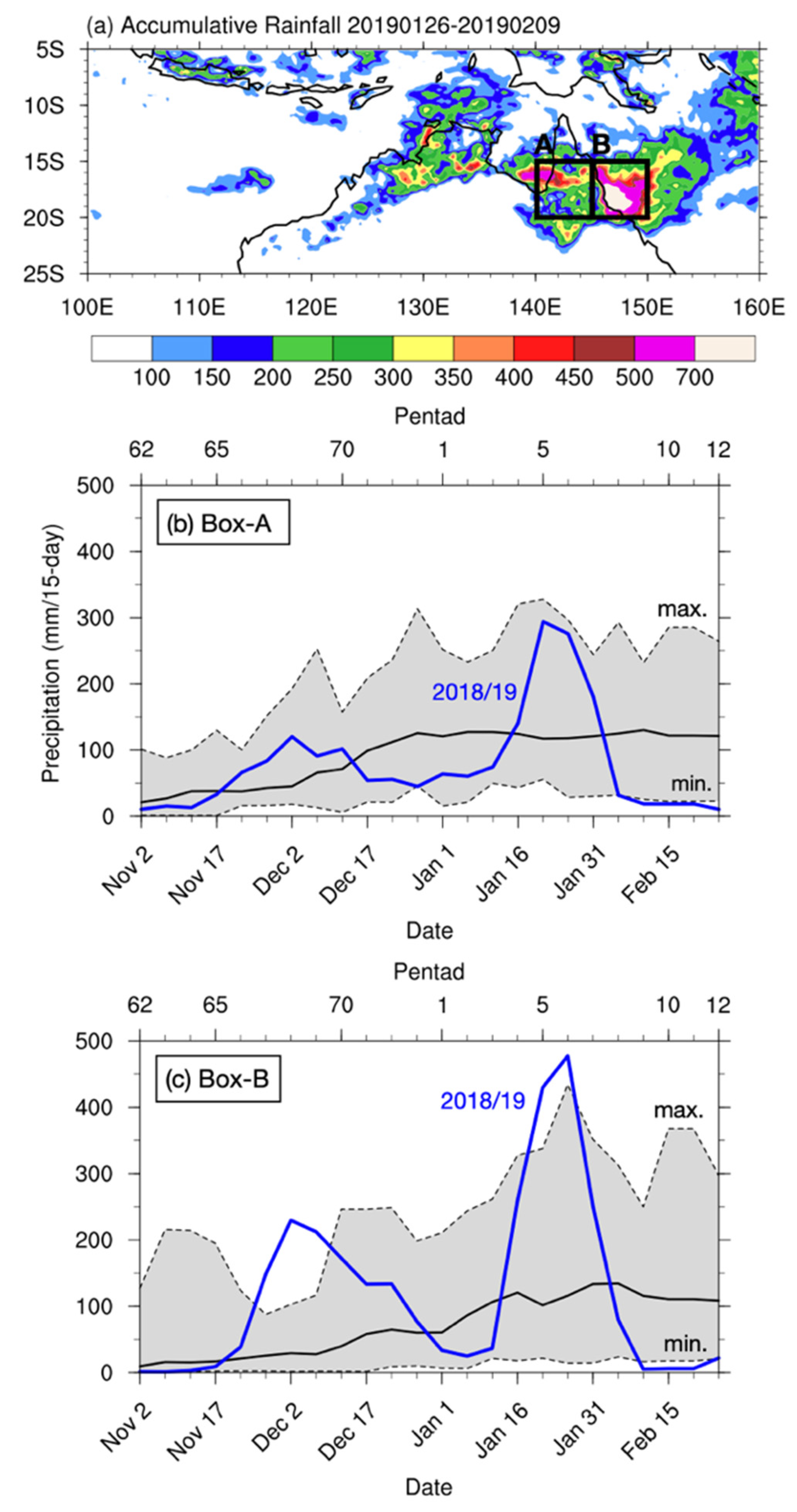
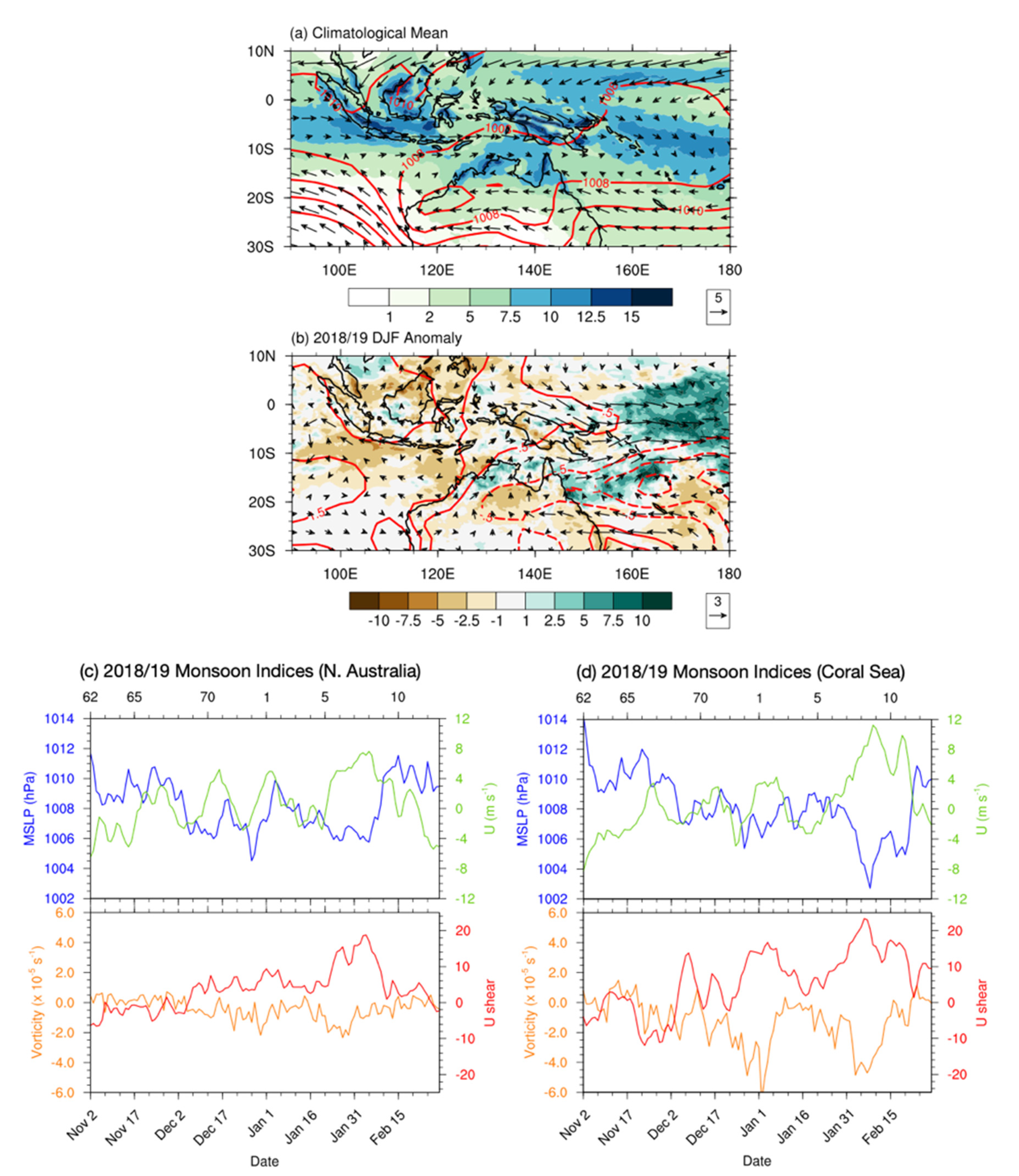
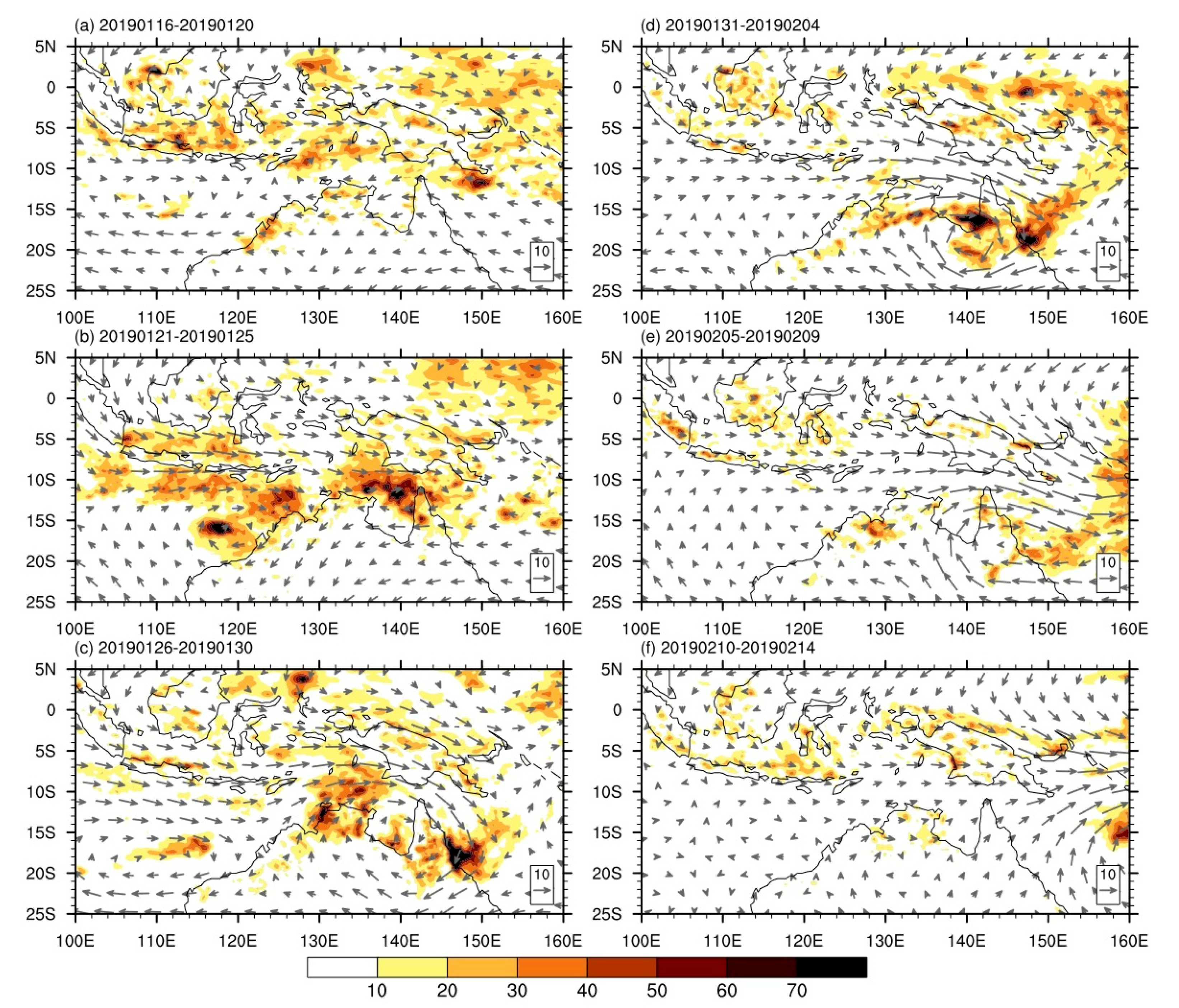

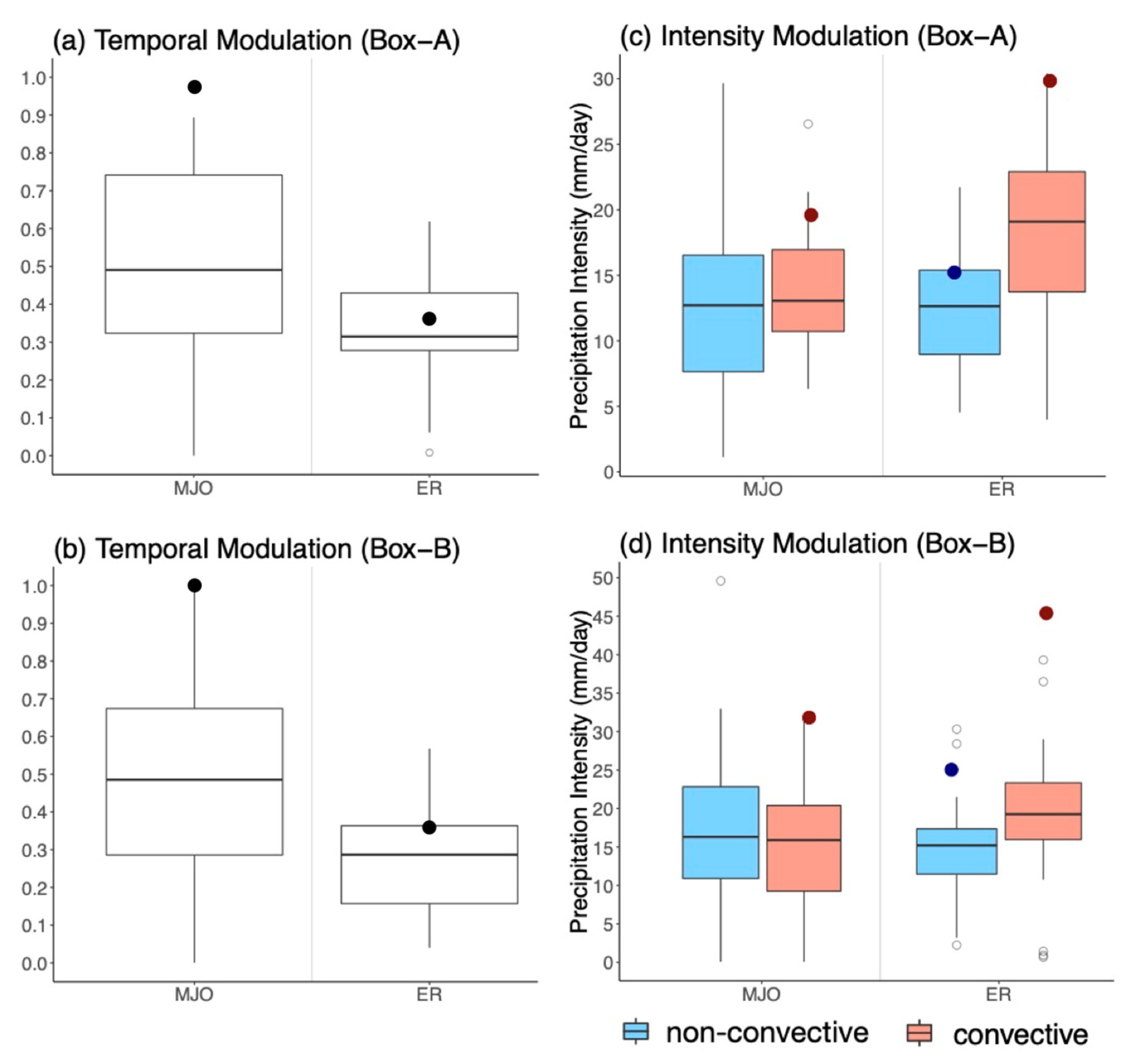

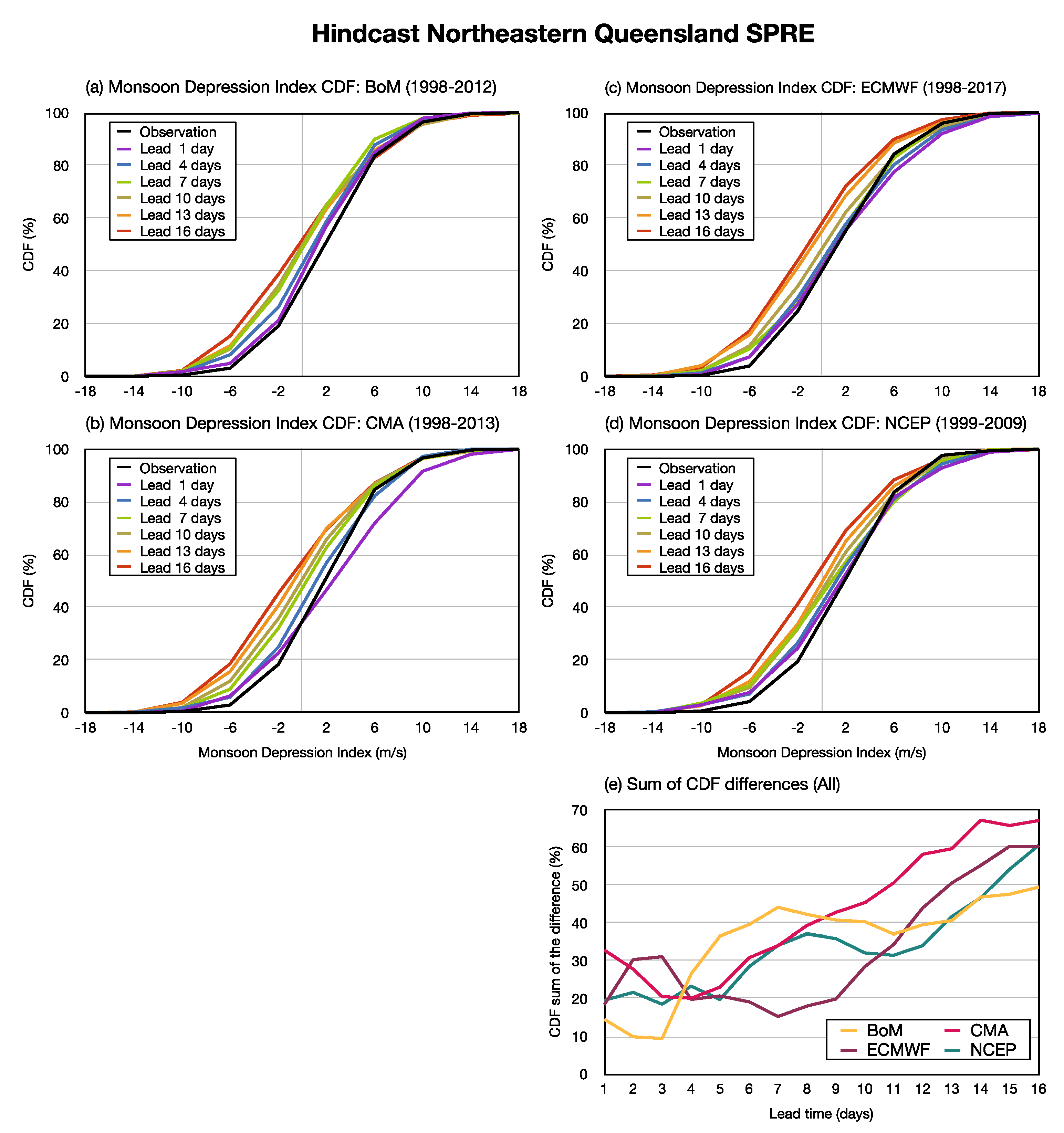
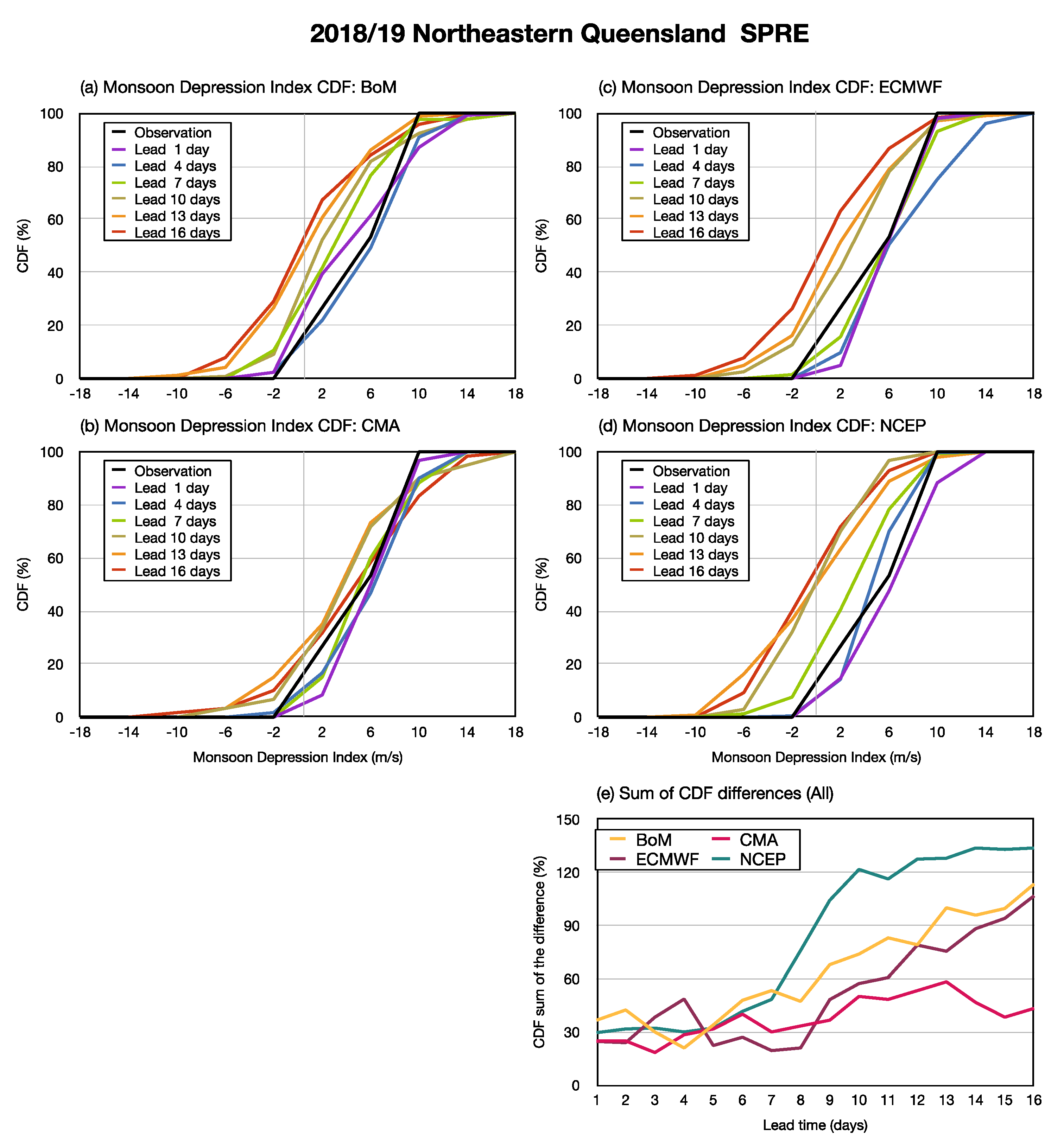

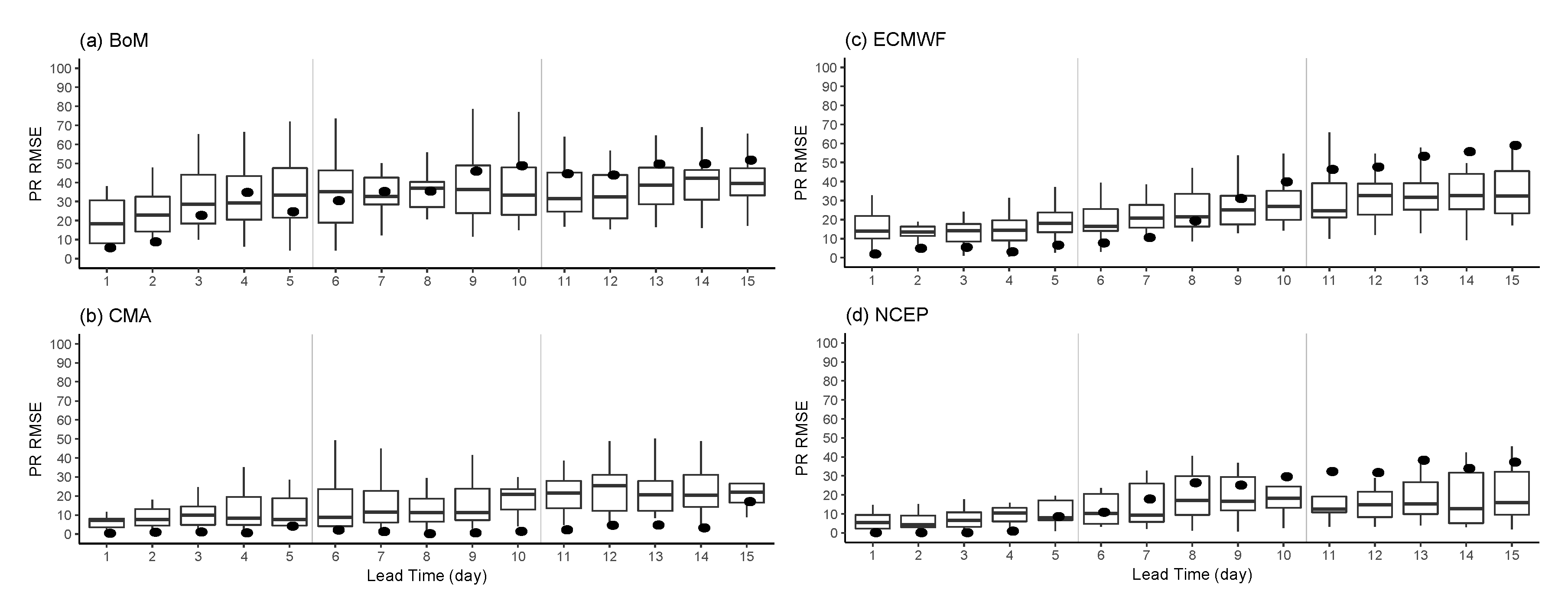
| Model | Time Range (Days) | Resolution | Ensemble Size | Frequency | Hindcast (Rfc.) | Rfc. Period | Rfc. Frequency | Rfc. Size |
|---|---|---|---|---|---|---|---|---|
| BoM | 0 to 62 | 2.5° × 2.5° | 33 | 2/Week | Fixed | 1981~2013 | 6/Month | 33 |
| CMA | 0 to 60 | 1.5° × 1.5° | 4 | Daily | Fixed | 1994~2014 | Daily | 4 |
| ECCC | 0 to 32 | 1.5° × 1.5° | 21 | Weekly | On the fly | 1998~2017 | Weekly | 4 |
| ECMWF | 0 to 46 | 1.5° × 1.5° | 51 | 2/Week | On the fly | Past 20 yrs. | 2/Week | 11 |
| HMCR | 0 to 62 | 1.5° × 1.5° | 20 | Weekly | On the fly | 1995~2010 | Weekly | 10 |
| CNR-ISAC | 0 to 32 | 1.5° × 1.5° | 41 | Weekly | Fixed | 1981~2010 | 1/Pentad | 5 |
| JMA | 0.5 to 33.5 | 1.5° × 1.5° | 50 | 2/Week | Fixed | 1981~2012 | 3/Month | 5 |
| KMA | 0 to 60 | 1.5° × 1.5° | 4 | Daily | On the fly | 1991~2010 | 4/Month | 3 |
| CNRM | 0 to 61 | 1.5° × 1.5° | 51 | Weekly | Fixed | 1993~2014 | 4/Month | 15 |
| NCEP | 0 to 44 | 1.5° × 1.5° | 16 | Daily | Fixed | 1999~2010 | Daily | 4 |
| UKMO | 0 to 60 | 1.5° × 1.5° | 4 | Daily | On the fly | 1993~2016 | 4/Month | 7 |
| Tropical Modes | Planetary Zonal Wavenumber (k) | Period (ω) | Equivalent Depth (h) |
|---|---|---|---|
| MJO | 1 to 5 | 30 to 96 | N/A |
| Equatorial Rossby (ER) wave | −10 to −1 | 9.7 to 48 | 8 to 90 |
| Year | Box-A (140°~145° E, 15°~20° S) | Box-B (145°~150° E, 15°~20° S) | ||||||||
|---|---|---|---|---|---|---|---|---|---|---|
| Occurrence Pentad | Rainfall Amount (mm) | Ratio (%) | MJO | ER Wave | Occurrence Pentad | Rainfall Amount (mm) | Ratio (%) | MJO | ER Wave | |
| 1998 | 1 | 164.5 | 22.3 | Y | Y | 2 | 243.5 | 32.4 | Y | |
| 1999 | 10 | 241.1 | 34.0 | Y | 10 | 367.8 | 40.6 | Y | ||
| 2000 | 69 | 252.7 | 29.8 | Y | 9 | 246.5 | 33.0 | Y | Y | |
| 2001 | 9 | 222.0 | 32.9 | Y | Y | 8 | 161.0 | 49.3 | Y | Y |
| 2002 | 10 | 144.4 | 29.5 | Y | Y | 10 | 114.0 | 44.0 | Y | Y |
| 2003 | 3 | 180.9 | 27.2 | 7 | 247.8 | 48.3 | Y | Y | ||
| 2004 | 71 | 129.5 | 24.8 | Y | Y | 3 | 197.9 | 44.4 | Y | |
| 2005 | 5 | 207.7 | 39.4 | Y | Y | 4 | 202.9 | 51.0 | Y | Y |
| 2006 | 6 | 296.7 | 45.1 | Y | Y | 6 | 387.9 | 51.5 | Y | Y |
| 2007 | 8 | 292.9 | 30.1 | Y | Y | 10 | 315.7 | 33.5 | Y | |
| 2008 | 5 | 327.8 | 30.2 | Y | 6 | 434.3 | 39.8 | Y | Y | |
| 2009 | 4 | 262.8 | 31.8 | Y | Y | 4 | 327.4 | 47.3 | Y | Y |
| 2010 | 10 | 285.3 | 26.4 | Y | Y | 3 | 254.2 | 25.6 | Y | |
| 2011 | 5 | 222.2 | 32.3 | Y | Y | 5 | 223.8 | 36.1 | Y | |
| 2012 | 3 | 250.6 | 48.0 | Y | Y | 3 | 261.3 | 57.7 | Y | |
| 2013 | 6 | 262.7 | 32.7 | Y | 6 | 223.8 | 56.0 | Y | ||
| 2014 | 73 | 141.4 | 27.3 | Y | Y | 8 | 172.6 | 39.3 | Y | |
| 2015 | 71 | 173.1 | 44.5 | Y | Y | 71 | 122.8 | 53.4 | Y | Y |
| 2016 | 1 | 192.8 | 35.2 | Y | Y | 1 | 191.5 | 52.0 | Y | Y |
| 2017 | 4 | 126.2 | 29.9 | Y | Y | 10 | 209.0 | 43.1 | Y | Y |
| 2018 | 5 | 294.0 | 50.9 | Y | Y | 6 | 477.4 | 52.3 | Y | Y |
Publisher’s Note: MDPI stays neutral with regard to jurisdictional claims in published maps and institutional affiliations. |
© 2021 by the authors. Licensee MDPI, Basel, Switzerland. This article is an open access article distributed under the terms and conditions of the Creative Commons Attribution (CC BY) license (https://creativecommons.org/licenses/by/4.0/).
Share and Cite
Tsai, W.Y.-H.; Lu, M.-M.; Sui, C.-H.; Cho, Y.-M. Subseasonal Forecasts of the Northern Queensland Floods of February 2019: Causes and Forecast Evaluation. Atmosphere 2021, 12, 758. https://doi.org/10.3390/atmos12060758
Tsai WY-H, Lu M-M, Sui C-H, Cho Y-M. Subseasonal Forecasts of the Northern Queensland Floods of February 2019: Causes and Forecast Evaluation. Atmosphere. 2021; 12(6):758. https://doi.org/10.3390/atmos12060758
Chicago/Turabian StyleTsai, Wayne Yuan-Huai, Mong-Ming Lu, Chung-Hsiung Sui, and Yin-Min Cho. 2021. "Subseasonal Forecasts of the Northern Queensland Floods of February 2019: Causes and Forecast Evaluation" Atmosphere 12, no. 6: 758. https://doi.org/10.3390/atmos12060758
APA StyleTsai, W. Y.-H., Lu, M.-M., Sui, C.-H., & Cho, Y.-M. (2021). Subseasonal Forecasts of the Northern Queensland Floods of February 2019: Causes and Forecast Evaluation. Atmosphere, 12(6), 758. https://doi.org/10.3390/atmos12060758







